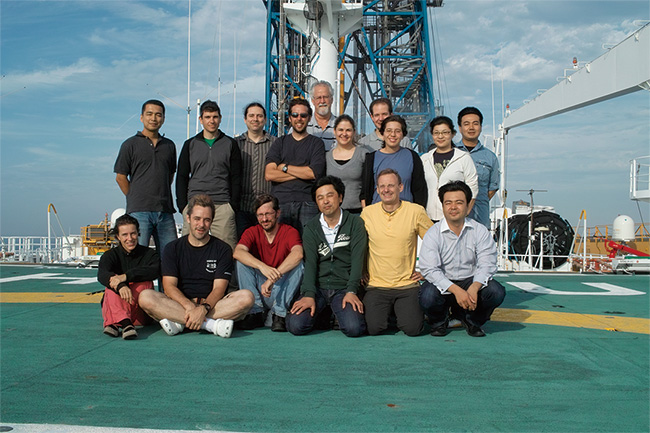Towards an understanding ofthe mechanism behind massive earthquakes
When these results are combined it becomes clear what happened at this fault at the time of the Tohoku Earthquake.
Firstly, the fault slipped deep in the plate boundary, and an earthquake was generated. When that was transmitted to the shallow area, the fault, having little strength, ruptured and frictional heat was generated. The pressure of the water inside the fault quickly rose due to this heat, the friction force rapidly dropped and a large slip was caused. A large slip also further increases the scale of the earthquake. Where slips in earthquakes in the past measured a few meters, the slip in the Tohoku Earthquake was in fact 50 m and of a different magnitude altogether. Because this occurred in a shallow area near the seafloor, the seafloor was lifted by 7-10 m and a large body of water was pushed upwards, creating a devastatingly massive tsunami.
Things needing further discussion naturally remain. This hasn't clarified the causes of all massive earthquakes and tsunamis. Says Kano, "We want to analyze the data we have obtained in further detail, and continue to study them."
However, there is no doubt that collecting samples from the plate boundary fault which generated a massive earthquake and directly measuring, in a world's first, traces of frictional heat generated in the earthquake, represents substantial progress in our understanding of the generation processes of massive earthquakes and tsunamis. The achievement of a difficult operation at a water depth of 7,000 m through the use of cutting-edge technologies is also significant.
Currently, a seismographic network is being put in place that includes the Dense Oceanfloor Network System for Earthquakes and Tsunamis (DONET) network in the Nankai Trough. Says Kano, “Measurements inside boreholes are less affected by noise from the surface or the seafloor and therefore allow for higher precision data. Also, if we consider earthquake generation cycles of hundreds or thousands of years, it is essential that we obtain stable data over long periods of time. We expect borehole observatories also to expand the range they can monitor." Signals from the hypocentre decrease with the increasing distance. To solve the mystery of the generation mechanism of massive earthquakes, “we want to monitor even just a little bit nearer where earthquakes actually occur,” tells Kano.

Memory of Expedition 319 (Demian Saffer, Sean Toczko, Yasuyuki Kano, Yoshinori Sanada)
Members of IODP Exp. 319, who have explained first riser drilling at IODP, lead JFAST and NanTroSEIZE.

